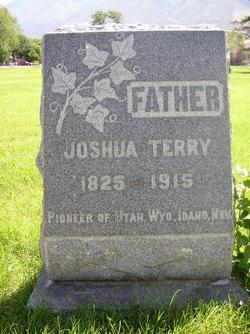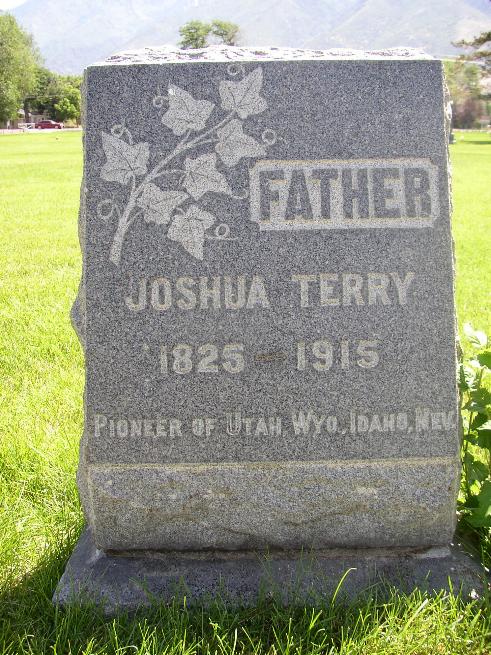Joshua Terry, brother of Amy Terry, wife of Zemira Draper. According to The Peoples of Utah, edited by Helen Z. Papanikdas, published by the Utah State Historical Society in Salt Lake City, Utah, Joshua Terry was a pioneer of September 1847. Joshua is part of a remarkable family sage that in its wider implications suggests the elements of the Canadian experience in pioneer Utah. His grandfather, Pennsylvania born, Parshall Terry II, deserted the revolutionary. Joshua's father, Parshall III, was born in New York. Parshall III had seven children born in Palmyra and the last six, including Joshua, at Albion, Upper Canada.The parents and most of the children converted to Mormonism in 1838, immigrated to Missouri, and followed the body to Illinois and then to Utah. Joshua became a mountain man and associate of Jim Bridger, and his first two wives were Indians. When most of his family came west in 1849, he and Bridger helped them along their way at Fort Bridger with six fresh oxen to pull the wagons on the last leg of the trek. Joshua's sister, Amy, married one of Brigham Young's early Canadian converts, Zermira Draper, who, with his brother William, founded Draper, Utah. Many of the Terry family moved there, some for the rest of their lives. Nevertheless, Zemira and William Draper and James and Jacob Terry were called to Cotton Mission and settled in faraway Rockville. There Zemira helped build a sawmill, a molasses mill, and a cotton mill, all of which used water power from the Virgin River. Joshua eventually settled down at Draper and often served as a link between the whites and the Indians of the Great Basin. His half-bred son, George, appointed by church leaders to work with the Shoshones, eventually became one of their chiefs. Thus, the family blended into the Utah environment and even into the native populace of the area.—Reference: Information obtained from the book, The Peoples of Utah, edited by Helen Z. Papanikolas. Chapter 8, The Oft-crossed Border: Canadians in Utah, written by Maureen Ursenbach and Richard I. Jensen, pp 285-286.
Joshua Terry, brother of Amy Terry, wife of Zemira Draper. According to The Peoples of Utah, edited by Helen Z. Papanikdas, published by the Utah State Historical Society in Salt Lake City, Utah, Joshua Terry was a pioneer of September 1847. Joshua is part of a remarkable family sage that in its wider implications suggests the elements of the Canadian experience in pioneer Utah. His grandfather, Pennsylvania born, Parshall Terry II, deserted the revolutionary. Joshua's father, Parshall III, was born in New York. Parshall III had seven children born in Palmyra and the last six, including Joshua, at Albion, Upper Canada.The parents and most of the children converted to Mormonism in 1838, immigrated to Missouri, and followed the body to Illinois and then to Utah. Joshua became a mountain man and associate of Jim Bridger, and his first two wives were Indians. When most of his family came west in 1849, he and Bridger helped them along their way at Fort Bridger with six fresh oxen to pull the wagons on the last leg of the trek. Joshua's sister, Amy, married one of Brigham Young's early Canadian converts, Zermira Draper, who, with his brother William, founded Draper, Utah. Many of the Terry family moved there, some for the rest of their lives. Nevertheless, Zemira and William Draper and James and Jacob Terry were called to Cotton Mission and settled in faraway Rockville. There Zemira helped build a sawmill, a molasses mill, and a cotton mill, all of which used water power from the Virgin River. Joshua eventually settled down at Draper and often served as a link between the whites and the Indians of the Great Basin. His half-bred son, George, appointed by church leaders to work with the Shoshones, eventually became one of their chiefs. Thus, the family blended into the Utah environment and even into the native populace of the area.—Reference: Information obtained from the book, The Peoples of Utah, edited by Helen Z. Papanikolas. Chapter 8, The Oft-crossed Border: Canadians in Utah, written by Maureen Ursenbach and Richard I. Jensen, pp 285-286.
Family Members
-
![]()
George Terry
1853–1907
-
![]()
Jane Rideout
1855–1876
-
![]()
William Johnson Terry
1856–1935
-
![]()
Mary Ann Terry Rideout
1858–1913
-
![]()
Joshua Parshall Terry
1860–1941
-
![]()
Sarah Ann Terry Ballard
1861–1940
-
![]()
Hunter Terry
1863–1945
-
![]()
Hannah Louisa Terry Brown
1865–1947
-
![]()
Deborah Rosetta Terry
1867–1879
-
![]()
Emma Elizabeth Terry Brown
1869–1948
-
![]()
Elisha Tarbox Terry
1871–1878
-
![]()
Joseph Hyrum Terry
1873–1878
-
![]()
Porter Moroni Terry
1875–1879
-
![]()
Valeria Prudence Terry
1877–1879
-
![]()
Dency Marilla Terry
1879–1879
-
![]()
Margery Ellenor Terry
1880–1880
-
![]()
Redell Steven Terry
1880–1948
Sponsored by Ancestry
Advertisement
Explore more
Sponsored by Ancestry
Advertisement

































